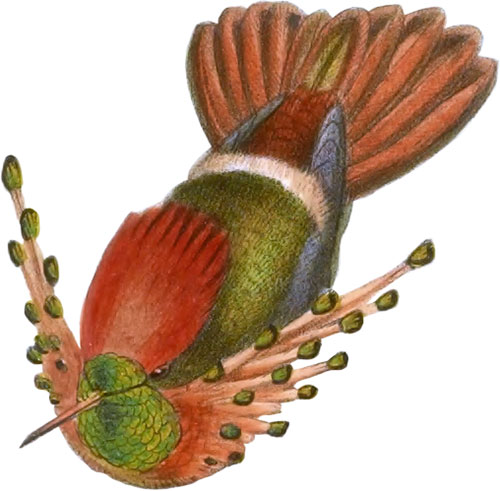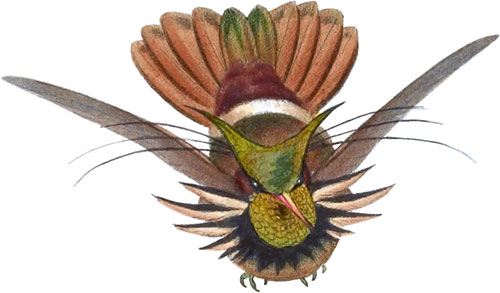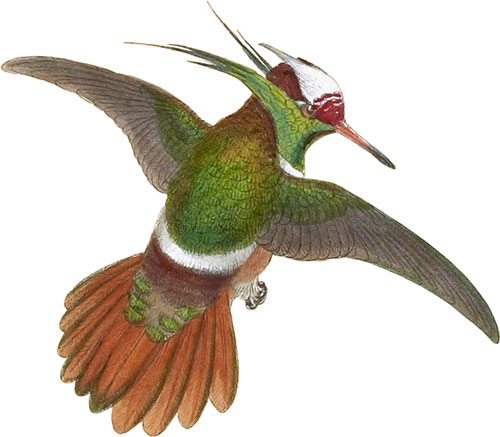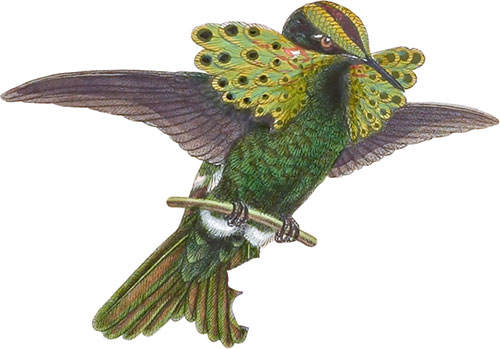As I had frequently been informed of the existence of a species of Lophornis with a crest, which, when outspread, resembled the tail of a Peacock, it was with no ordinary sensations of pleasure I first beheld the lovely little bird here depicted; specimens of which arrived in Europe for the first time in the year 1847, through the instrumentality of M. Linden of Brussels, who received it direct from his brother, at that time travelling in the province of Antioquia in Columbia.
Since that period several other examples have been received from the same source, and from the neighbouring countries; the native locality of this beautiful species is therefore placed beyond doubt.
The Lophornis Reginæ differs from every other known member of the genus in its large, round, and well-defined crest, each feather of which is surmounted by a ball-like, dark bronzy-green tip, which must render the bird a most conspicuous and pleasing object when the feathers are fully displayed.
The sexes exhibit the usual difference, the female being entirely destitute of the fine crest and rich colouring of the male.
I regret to add that no information has reached us respecting the habits and manners.
The male has the crown of the head and crest bright rusty red, each feather with a beautiful dark bronzygreen spot at the tip; lores, throat and sides of the neck luminous metallic green, beneath which is a patch of white lanceolate feathers; back of the neck and upper part of the back shining green; lower part of the back, rump, and upper tail-coverts bronzy brown; rump crossed by a narrow band of white; tail chestnutbrown, the tips and margins of the external feathers rich bronzy green; wings purplish brown; abdomen light metallic green; bill fleshy at the base, dark brown at the tip; feet brown.
The female has the forehead and crown deep buff; upper surface and wing-coverts bronzy green; lower part of the back dark or blackish brown, crossed by a band of white; wings purplish brown; tail buff, crossed towards the apex by a broad dusky semicircular band; throat dusky; under surface bronzy green.
The figures are of the natural size.
 Lophornis ornatus
Tufted Coquette
Lophornis ornatus
Tufted Coquette
 Lophornis Gouldi
Gould’s Coquette
Lophornis Gouldi
Gould’s Coquette
 Lophornis magnificus
Frilled Coquette
Lophornis magnificus
Frilled Coquette
 Lophornis Regulus
Great-Crested Coquette
Lophornis Regulus
Great-Crested Coquette
 Lophornis Delattrei
DeLattre’s Coquette
Lophornis Delattrei
DeLattre’s Coquette
 Lophornis Helenæ
Princess Helena’s Coquette
Lophornis Helenæ
Princess Helena’s Coquette
 Lophornis adorabilis
Salvin’s Coquette
Lophornis adorabilis
Salvin’s Coquette
 Lophornis pavoninus
Roraima Coquette
Lophornis pavoninus
Roraima Coquette
Featuring all 422 illustrated species from John Gould’s A Monograph of the Trochilidæ, or Family of Humming-Birds arranged by color.